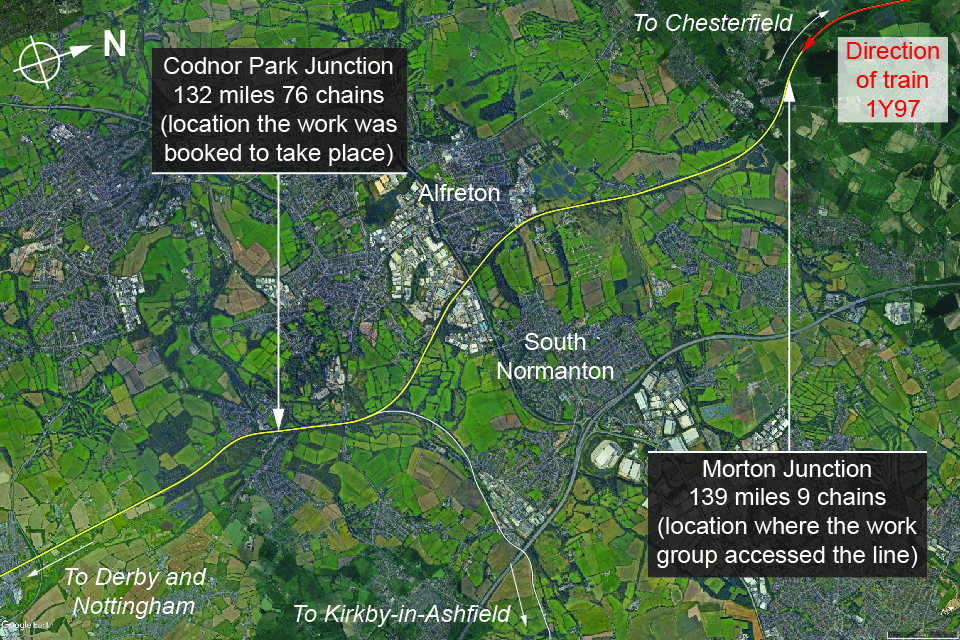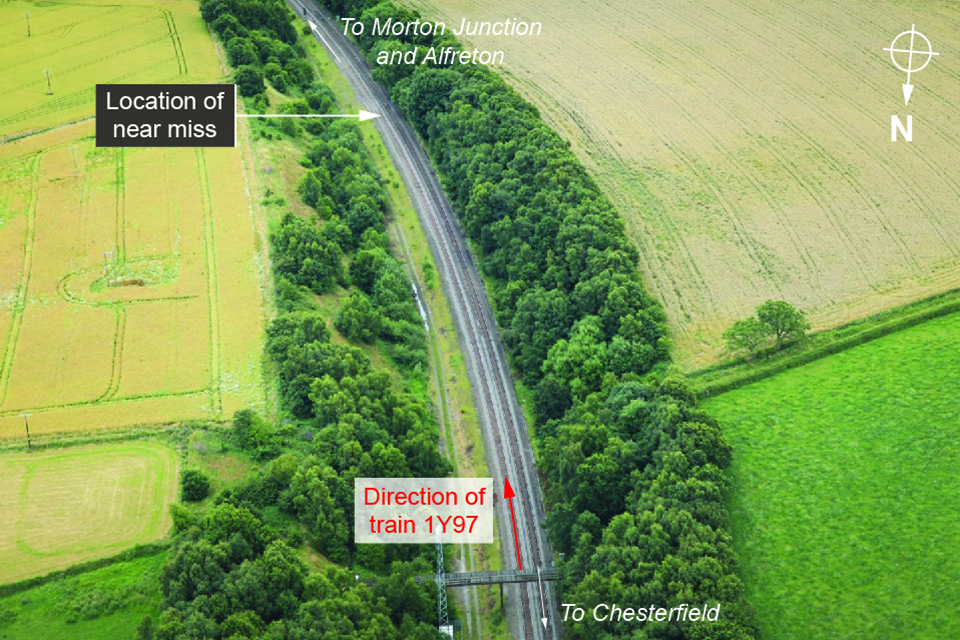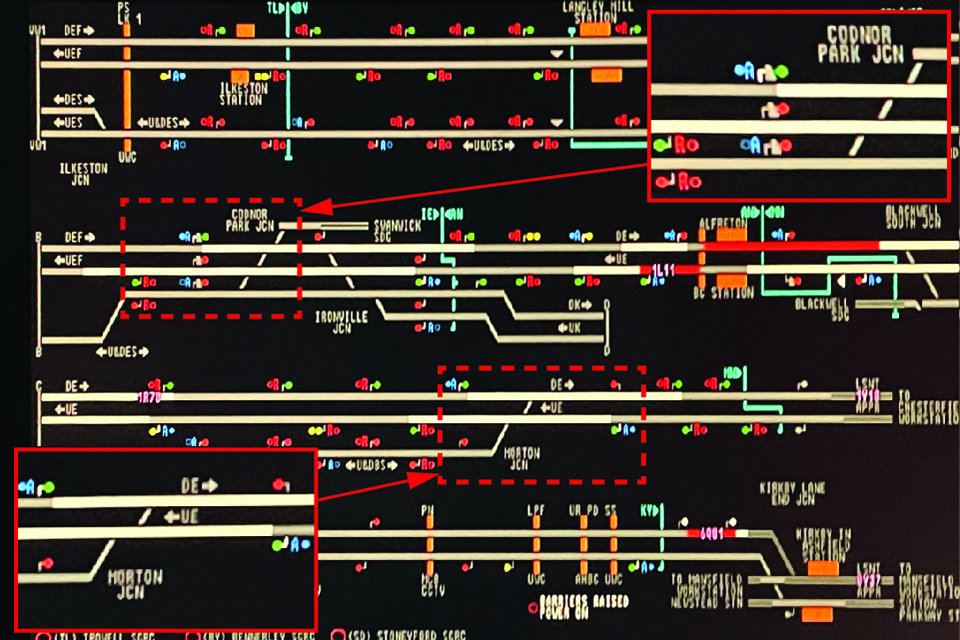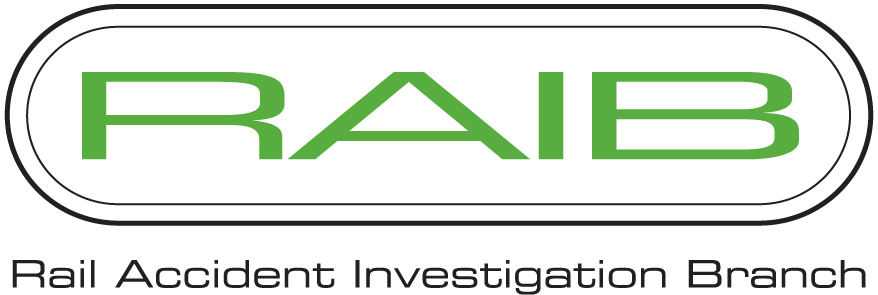Near miss with track workers at Morton Junction, 27 November 2024
Published 1 April 2025
1. Important safety messages
This incident demonstrates the importance of:
- any staff involved with planning or scheduling tasks ensuring that changes to the documentation supporting work on or near the line are clearly communicated to the relevant person in charge
- persons in charge ensuring that they have the correct safe work pack for the work and that this is used to brief staff before starting work, regardless of their familiarity with the location or task
- signallers, persons in charge and controllers of site safety reaching a clear, mutual understanding of the location of work groups when requesting a line blockage.
2. Summary of the incident
At about 07:26 on 27 November 2024, a passenger train travelling at around 78 mph (125 km/h) was involved in a near miss with a group of track workers. The incident took place near Morton Junction on the Erewash Valley line, approximately 2.4 miles (3.9 km) north of Alfreton station. At the time of the incident, the train was travelling on the Up Erewash line towards Alfreton.
The workers involved were a controller of site safety (COSS) and two track workers who were part of a larger group preparing to correct a track fault. As the train approached and sounded its horn, the COSS and the two track workers moved clear of the track and out of the swept path of the approaching train. Forward-facing CCTV (FFCCTV) footage shows that they moved clear of the track around 2 seconds before the train passed.
3. Cause of the incident
The group had planned to work using line blockages which stop train movements on the line(s) that staff are working on by maintaining protecting signals at red (danger). The near miss occurred because the COSS unintentionally blocked a section of line at Codnor Park Junction, while the group were on site at Morton Junction, around 7 miles (11.3 km) to the north, on the same route. This meant that the section of track the group was accessing was still open to rail traffic, placing them at risk of being struck.
When the line blockage was being arranged, neither the signaller nor the COSS realised that the group was not at the location that was to be blocked by the protecting signals. The COSS reported that they had unknowingly used a safe work pack (SWP) for a different location to that where the work group was actually located.

Map showing approximate location of incident (courtesy of Google Maps, with RAIB annotations).
The railway immediately north of Morton Junction consists of two lines running approximately north to south: the Up Erewash line heading south to Nottingham and the Down Erewash line heading north to Chesterfield. Both lines have a permissible speed of 80 mph (129 km/h), and both were open to traffic at the time of the incident.
The work group involved consisted of the COSS and five track workers, all of whom were employed by Network Rail as local maintenance staff. They were all familiar with both Morton and Codnor Junctions, having worked there many times previously. The COSS was also the person in charge (PIC) for the work. A PIC is responsible for all aspects of safety while the team is on the track. The group accessed the railway to undertake planned lifting and packing works on both the Up and Down Erewash lines. The safe system of work the team planned to use was based on a series of pre-planned line blockages between timetabled trains.
During the week leading up to the incident, the COSS was issued with a production sheet which summarised the planned work and shift pattern for their group. Details on the production sheet included dates and times, the location, the type of work being undertaken, the allocated COSS, and the SWP identification number for each individual package of work.
On the production sheet for that week, two sites, one at Morton Junction and one at Codnor Park Junction, were identified as requiring work that would need line blockages. The type of work that was planned for both locations (lifting the sleepers and packing ballast underneath) was similar. The work at Morton Junction was initially scheduled for Wednesday 27 November 2024 and the works at Codnor Park Junction for Thursday 28 November 2024.
Before the production sheet was issued to staff by the section supervisor, difficulties with obtaining line blockages at Morton Junction on 27 November led to the decision to swap the two shifts over. Line blockage requests were then made for Codnor Park Junction on 27 November and Morton Junction on 28 November. The production sheet was updated accordingly; however the changes were not saved, so it reverted to the original version, which was subsequently issued to staff. This meant that the original SWP number that had been allocated to Morton Junction SWP was kept for the Codnor Park Junction SWP and vice versa.
The SWP for Codnor Park Junction was planned, verified and authorised between 22 and 23 November in Railhub (the online system used by Network Rail to plan and authorise SWPs) in accordance with Network Rail standards. It was verified by the COSS (in his role as PIC) on 23 November. The line blockage details for the work at Codnor Park Junction had been sent to the controlling signaller on the Erewash workstation at Network Rail’s East Midlands control centre (EMCC) on 26 November. This workstation controls the signals around both Codnor Park and Morton Junctions.
The COSS finished 5 weeks of rostered night duties on 23 November and had 3 rest days before starting day shifts on the morning of 27 November. Witness evidence indicates that the COSS felt tired when they arrived at Derby maintenance delivery unit at 05:45 but felt still able to fulfil their duties.
On arrival, the COSS used the production sheet to check the location of the work for the day. The sheet stated that the group was to work at Morton Junction. The COSS then signed the group into the SWP on Railhub for that day. The COSS did not realise the SWP they were using was for Codnor Park Junction, having not fully read the SWP before using it. After the rest of the group signed the SWP, they all departed for site at around 06:30.

The location where the near miss occurred (courtesy of Network Rail, with RAIB annotations).
The Network Rail signaller controlling the Erewash line panel started work at 06:30, on a rostered 12-hour day shift. The signaller spent the first part of the shift familiarising themself with the line blockage requests for that day, including the request for Codnor Park Junction.
The work group arrived on site at Morton Junction at around 07:05 and entered the railway at a local access point. Witness evidence indicates that the COSS then delivered the site briefing to the team about the hazards present on the site. The COSS based this on their previous experience of working in the area, not referring to the SWP, as they were familiar with both the location and the work to be undertaken.
The COSS contacted the signaller at 07:10 to set up the first line blockage and used a form included in the SWP to confirm the numbers of the signals to be blocked (held at danger/red). This form had been prepopulated during the planning of the work and included the signal numbers for the planned line blockage at Codnor Park Junction. The COSS did not realise that the signal numbers they were using did not correspond to the signals which would protect the group’s current location.
During the conversation with the signaller to confirm the line blockage arrangements, the COSS stated several times that the group was at Morton Junction. The signaller repeated the location back and wrote Morton Junction on the signaller’s copy of the forms. The signaller did not appreciate when doing this that the signal numbers being quoted were not for Morton Junction. The signaller confirmed they would call back when a suitable gap in traffic was available to allow the COSS to start work.

Erewash signaller’s panel showing locations of Codnor Park and Morton Junctions.
At 07:19, the signaller called the COSS to confirm that a 10-minute line blockage (with a handback time of 07:31) was available based on the signal numbers that had been previously agreed. The signaller then blocked the agreed signals which were at Codnor Park Junction.
At 07:20, train 1Y97 left Chesterfield station heading south towards Alfreton. The train was being driven by a trainee driver with a driver instructor also present in the cab. On-train data recorder evidence and FFCCTV images show that the train approached the COSS and the workgroup at 07:26. The COSS and two track workers were standing on the track in the path of the train as it approached.
The COSS and track workers were obscured from the driver’s view until around 5 seconds before the train reached them. This was due to the train approaching them around a curve and because of the poor visibility caused by low light and heavy rain. Around 1 second later, with the train travelling at 78 mph (125 km/h), the driver instructor reacted to the sighting of the group and sounded the horn to warn of the train’s approach. FFCCTV images show that, in response, the COSS and track workers moved off the track and were clear of the train’s path around 2 seconds before it passed them.
The COSS reported the near miss to the signaller at 07:28. The driver instructor reported the near miss to the signaller when they arrived at Alfreton station at 07:29. At 07:31, the signaller rang the COSS to lift the line blockage using the details that had been previously agreed. It was at this point that the COSS realised that the signal numbers used related to Codnor Park Junction, not Morton Junction.
While acting in the role of PIC and to achieve compliance to NR/L2/OHS/019, the COSS was required to brief the group before starting work. Had the COSS used the SWP for this briefing, they would almost certainly have realised that the incorrect pack was being used before the group went on to the track.
Rule Book GERT8000-HB8, ‘Handbook 8 - IWA, COSS or PC blocking a line’, issue 10, provides instructions to people holding these competencies who need to block a line to rail traffic. This handbook states that the individual requesting the line blockage is to clearly agree with the signaller the locations between which the work is to take place, and which signals will be kept at danger to protect the activity being undertaken.
Rule Book Module GERT8000-TS1, ‘General signalling regulations’, issue 18.1, also provides rules regarding what arrangements must be agreed between the signaller and the individual making the request to block the line. These include a similar requirement for the signaller to clearly identify the locations between which the work is to take place and the protecting signals. During any safety‑critical communication involving a line blockage, it is the signaller who has the responsibility for leading the conversation and ensuring that a clear understanding is reached.
Staff entering railway infrastructure often use physical features such as access points, structures or other physical landmarks to indicate their location whereas signallers more commonly refer to signal and point numbers. However, in this instance the COSS gave protecting signal numbers and a named location, both of which were repeated back by the signaller. Despite this, the discrepancy between the protecting signals and the location was not noticed by the signaller, who granted the line blockage.
In January 2025, Network Rail’s Safety Central website issued safety advice to all Network Rail line managers, safety professionals and accredited contractors. This advice stated that Network Rail had developed the ‘Access Point’ app due to the continuing high number of incidents where incorrect location awareness had been a factor. This app is intended to support the information in SWPs. It allows users to geographically locate where they are accessing the infrastructure and to see the relevant information held within the National Hazard Directory and sectional appendix.
4. Previous similar occurrences
Many incidents and accidents involving track workers have been investigated by RAIB. Some of these resulted in fatalities or had the potential to do so. Those with similarities to the incident at Morton Junction include:
- A near miss between a train and a track worker near to Euxton Junction on the West Coast Main Line (safety digest 05/2024). This incident occurred because the COSS misidentified which of the railway lines at the location had been blocked to the passage of trains. Although signage at one of the access points used by the team correctly showed the layout of the track, the COSS did not spot the error. The error was also not challenged by the other member of the team during a briefing given by the COSS.
- A near miss with four track workers around 2 miles (3.2 km) west of Dundee station (safety digest 11/2018). The incident occurred because the location at which the work was being done and the location where the line blockage was established were different. Lines had been blocked to allow the work to be carried out, but the line blockage was actually about 2 miles east, rather than west, of Dundee station. From zero datum points either side of Dundee station, railway mileages increase both to the east and west of Dundee. Therefore, the mileage at the site of the work appeared to be consistent with that for the blockage; however, these mileages referred to different sections of line. This confusion arose at several points in the planning process.
A wider summary of previous RAIB learning, including more similar incidents relating to track worker near misses, can be found on RAIB’s website.

